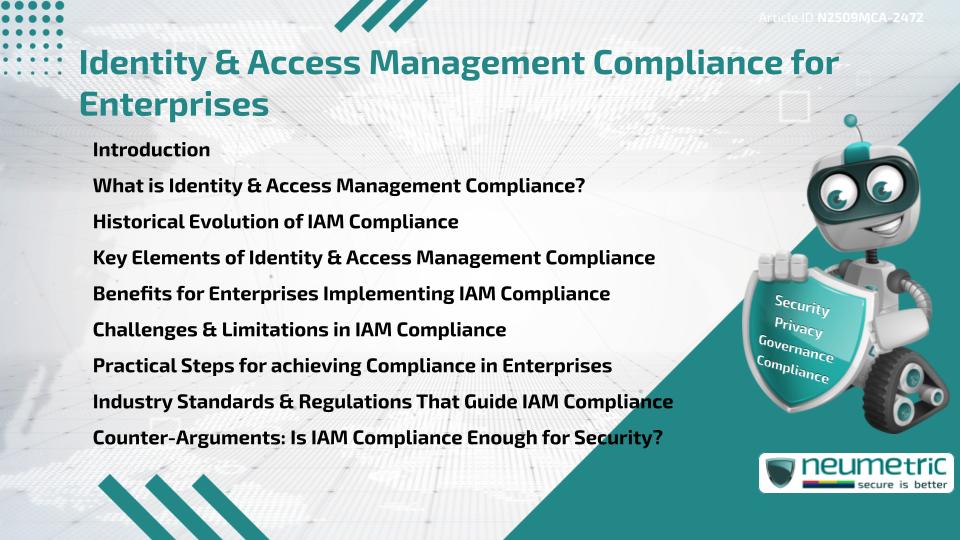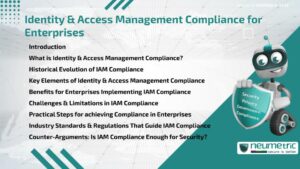Table of Contents
ToggleIntroduction
Identity and Access Management Compliance is a vital aspect of modern Enterprise Security. It ensures that only authorised users can access Critical Systems & Data, while also verifying that Organisations meet Legal & Regulatory requirements. By aligning with Identity and Access Management Compliance standards, enterprises can reduce Risks, strengthen Accountability & demonstrate Due Diligence. This article explores what Identity and Access Management Compliance is, its history, core elements, benefits, challenges & practical steps for enterprises.
What is Identity and Access Management Compliance?
Identity and Access Management Compliance refers to the adherence to rules, standards & Best Practices that regulate how enterprises manage digital identities & access permissions.
Much like a key-and-lock system in physical security, IAM ensures that only the right individuals hold the keys to specific digital doors. Compliance guarantees that these digital keys are issued, monitored & revoked in line with regulatory & security expectations.
Historical Evolution of IAM Compliance
IAM practices began gaining prominence in the late twentieth century, when enterprises adopted centralised directory services like LDAP & Active Directory. Early Compliance drivers included Government regulations around Financial Accountability & Privacy.
Regulatory frameworks such as Sarbanes-Oxley Act [SOX], HIPAA & the General Data Protection Regulation [GDPR] reinforced the need for formal IAM programs. Over time, IAM Compliance evolved from simple password management into advanced practices like Multifactor Authentication, Privileged Access Management & Zero Trust models.
Key Elements of Identity and Access Management Compliance
A strong IAM Compliance Framework typically includes:
- User Provisioning: Standardised onboarding & offboarding processes.
- Authentication Controls: Use of strong authentication methods such as Multifactor Authentication.
- Role-Based Access Control [RBAC]: Ensuring users only access resources relevant to their roles.
- Privileged Account Management: Monitoring & Controlling administrator-level access.
- Audit & Reporting: Regular reviews of Access Logs & Compliance Reports.
These elements ensure enterprises maintain Accountability & control over sensitive systems.
Benefits for Enterprises Implementing IAM Compliance
The adoption of IAM Compliance provides enterprises with multiple advantages:
- Regulatory Alignment: Demonstrates Compliance with laws like SOX, HIPAA & GDPR.
- Risk Reduction: Prevents unauthorised access & potential data breaches.
- Operational Efficiency: Automates identity processes & reduces administrative errors.
- Improved Trust: Builds confidence with Customers, Partners & Regulators.
Enterprises that implement IAM Compliance effectively often find it easier to pass Audits & maintain strong reputations.
Challenges & Limitations in IAM Compliance
IAM Compliance also presents challenges. Enterprises with complex environments or multiple systems may find it difficult to achieve centralised oversight. Legacy systems can complicate integration with modern IAM solutions. Overly strict Compliance rules may frustrate users, leading to workarounds that undermine security.
Practical Steps for achieving Compliance in Enterprises
To achieve Identity and Access Management Compliance, enterprises should:
- Develop clear IAM Policies aligned with Regulatory frameworks.
- Use automated tools for User provisioning & access monitoring.
- Enforce strong authentication methods across systems.
- Conduct regular Audits of access permissions & usage.
- Train Employees to recognise & follow IAM Policies.
By embedding these practices into daily operations, enterprises can reduce Risks & streamline Compliance.
Industry Standards & Regulations That Guide IAM Compliance
Several standards & regulations provide direction for IAM Compliance:
- ISO 27001 for Information Security management.
- GDPR for Privacy & Data Protection.
- HIPAA for Healthcare security.
- SOX for Financial Accountability.
These frameworks ensure that IAM Compliance practices meet global regulatory expectations.
Counter-Arguments: Is IAM Compliance Enough for Security?
Some argue that IAM Compliance alone does not guarantee Enterprise Security. While Compliance helps establish strong foundations, it often represents minimum requirements. Cybercriminals continually evolve their tactics & Compliance frameworks may lag behind emerging Threats. Enterprises must therefore supplement Compliance with adaptive security strategies such as Behavioral Analytics & Continuous Monitoring.
Conclusion
Identity and Access Management Compliance is essential for enterprises navigating complex digital environments. It ensures Regulatory alignment, protects Sensitive Systems & builds Trust with Stakeholders. Though challenges exist, IAM Compliance remains a cornerstone of modern enterprise security.
Takeaways
- Identity and Access Management Compliance ensures Accountability in Access Control.
- It reduces Risks while aligning Enterprises with Regulatory requirements.
- Standards like ISO 27001, GDPR, HIPAA & SOX guide IAM Compliance.
- Compliance must be complemented by advanced, proactive Security Measures.
FAQ
What is the main goal of Identity and Access Management Compliance?
Its main goal is to ensure digital identities & access rights are managed securely & in line with regulatory requirements.
How does IAM Compliance help enterprises?
It reduces risks of unauthorised access, improves operational efficiency & ensures regulatory alignment.
Do all enterprises need IAM Compliance?
Yes. Any enterprise that manages digital identities or Sensitive Data benefits from IAM Compliance.
What happens if enterprises fail IAM Compliance checks?
They may face Financial penalties, reputational damage & increased Risk of data breaches.
Can IAM Compliance be automated?
Yes. Many enterprises use IAM platforms to automate provisioning, monitoring & reporting processes.
How often should IAM Compliance audits be performed?
At least annually, with more frequent Audits for high-Risk environments or industries.
Does IAM Compliance guarantee complete security?
No. Compliance reduces Risks but must be combined with proactive monitoring & adaptive security practices.
Need help for Security, Privacy, Governance & VAPT?
Neumetric provides organisations the necessary help to achieve their Cybersecurity, Compliance, Governance, Privacy, Certifications & Pentesting needs.
Organisations & Businesses, specifically those which provide SaaS & AI Solutions in the Fintech, BFSI & other regulated sectors, usually need a Cybersecurity Partner for meeting & maintaining the ongoing Security & Privacy needs & requirements of their Enterprise Clients & Privacy conscious Customers.
SOC 2, ISO 27001, ISO 42001, NIST, HIPAA, HECVAT, EU GDPR are some of the Frameworks that are served by Fusion – a SaaS, multimodular, multitenant, centralised, automated, Cybersecurity & Compliance Management system.
Neumetric also provides Expert Services for technical security which covers VAPT for Web Applications, APIs, iOS & Android Mobile Apps, Security Testing for AWS & other Cloud Environments & Cloud Infrastructure & other similar scopes.
Reach out to us by Email or filling out the Contact Form…





